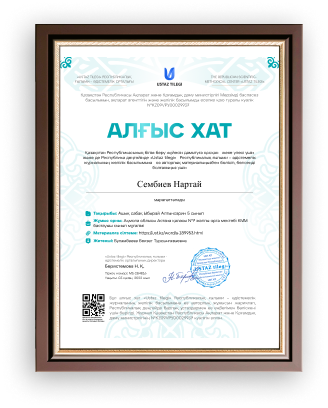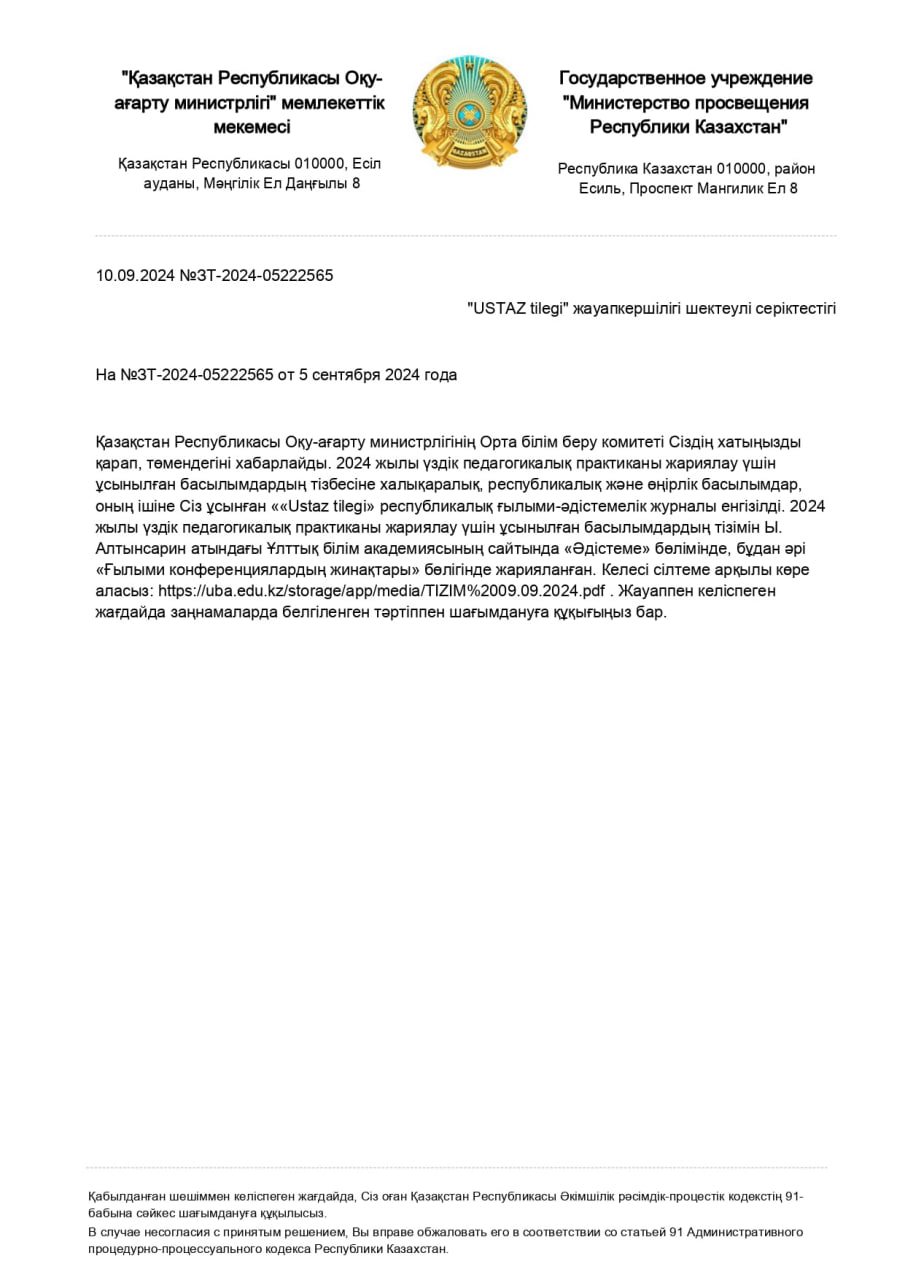Мақала
«Effective use of critical
thinking in improving the quality of knowledge of English
lessons»
Annotation:
Title: Effective Use of Critical
Thinking in Improving the Quality of Knowledge in English
Lessons
Purpose:
The purpose of this article is to explore the significance of
integrating critical thinking strategies into English lessons and
to demonstrate how such techniques can enhance students'
comprehension, analytical skills, and overall learning outcomes.
The article emphasizes the importance of fostering critical
thinking in language learning as a way to engage students more
effectively and help them develop the ability to think deeply,
reason logically, and form well-supported arguments in
English.
Introduction:
In the modern educational landscape, where traditional teaching
methods may no longer suffice to address the diverse needs of
learners, critical thinking plays a crucial role in transforming
the learning process. This article delves into how the application
of critical thinking not only improves students' linguistic
abilities but also equips them with the necessary skills to
analyze, evaluate, and create complex ideas in English. By engaging
students in thoughtful discussions, problem-solving, and
decision-making activities, educators can significantly enhance the
quality of knowledge that students gain from their English
lessons.
Main Body:
The article discusses several
methods for incorporating critical thinking in English language
teaching, such as:
-
Questioning
techniques: Encouraging students to ask
open-ended, thought-provoking questions during lessons to promote
deeper thinking.
-
Problem-solving
tasks: Implementing activities that
require students to apply their English language skills to solve
real-world problems or hypothetical
scenarios.
-
Group discussions and
debates: Using collaborative activities
to engage students in discussions that require them to defend their
ideas and consider alternative
perspectives.
-
Analytical reading and
writing exercises: Providing opportunities for
students to critically analyze texts and produce well-structured
arguments in written form.
One of the most effective ways
to promote critical thinking in English lessons is through the
analysis of literature. By engaging with different genres, themes,
and writing styles, students are encouraged to interpret and
critique texts in a variety of ways. Teachers can ask students to
identify underlying themes, assess characters’ motivations, or
explore alternative endings, which promotes both comprehension and
critical reflection. These activities not only develop language
skills but also encourage students to think independently, make
connections between ideas, and challenge assumptions in the text.
By honing these skills, students are better prepared to apply
critical thinking to other areas of their learning. Another
powerful method for integrating critical thinking in English
lessons is the use of reflection and self-assessment activities.
Encouraging students to regularly reflect on their learning process
helps them develop metacognitive skills, which are essential for
self-improvement. Students can be asked to assess their strengths
and areas for growth in writing, speaking, or listening tasks, and
think critically about how they can improve. By fostering
self-awareness and encouraging them to take ownership of their
learning, teachers provide students with the tools they need to
become lifelong learners who approach challenges thoughtfully and
independently. Problem-Based Learning (PBL) is a dynamic teaching
method where students work collaboratively to solve complex,
real-world problems. In an English language classroom, PBL can
involve tasks such as developing a proposal, creating a persuasive
argument, or conducting a research project on a contemporary social
issue. This approach fosters critical thinking by requiring
students to analyze the problem, gather relevant information,
consider various perspectives, and develop practical solutions. PBL
also allows students to engage with English in authentic contexts,
improving both their language proficiency and problem-solving
abilities. Debates and persuasive communication activities are
valuable in fostering critical thinking in English lessons. By
encouraging students to take a stance on an issue and support their
arguments with evidence, debates challenge them to think critically
and logically. This method allows students to practice their
language skills in a structured, argumentative context, which not
only improves their ability to communicate effectively but also
sharpens their analytical thinking. Teachers can guide students in
recognizing the importance of credible sources, clear reasoning,
and the art of persuasion, skills that will be beneficial beyond
the classroom.
Conclusion:
Incorporating critical thinking in English lessons not only
increases the quality of knowledge but also fosters greater student
engagement and motivation. By encouraging students to think
critically, teachers help them develop lifelong skills that will
benefit them in all aspects of their academic and personal lives.
The article concludes by emphasizing the need for educators to
continuously adapt their teaching methods to include strategies
that nurture critical thinking, thereby improving the overall
effectiveness of English instruction.
References:
-
Johnson, D. W., & Johnson, R.
T. (2014). Critical thinking and its
role in language learning. Educational Psychology Review, 26(3),
345-366.
-
Paul, R., & Elder, L.
(2013). Critical thinking: Tools
for taking charge of your learning and your
life. Pearson Education.
-
Brookfield, S.
(2012). Teaching for critical
thinking: Tools and techniques to help students question their
assumptions. Jossey-Bass.


















